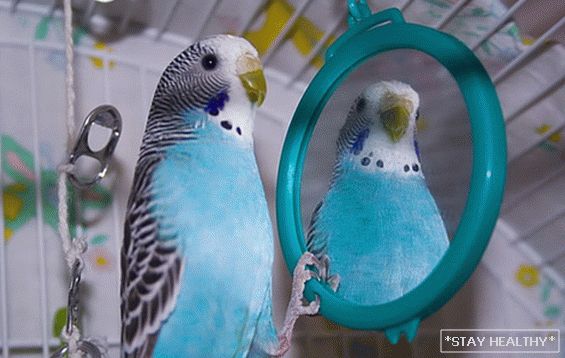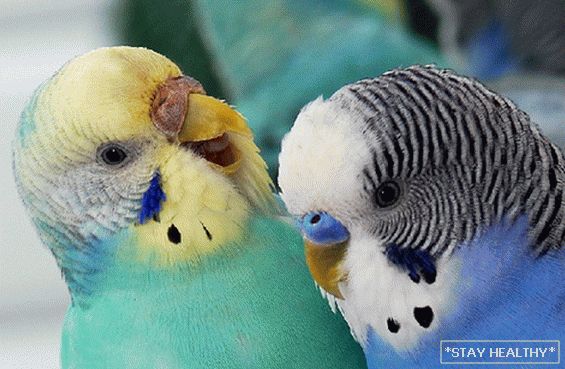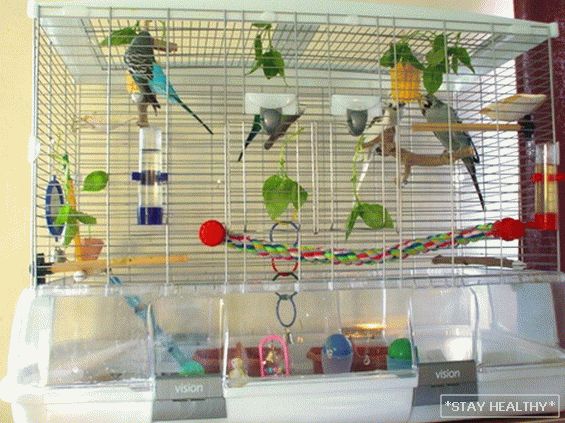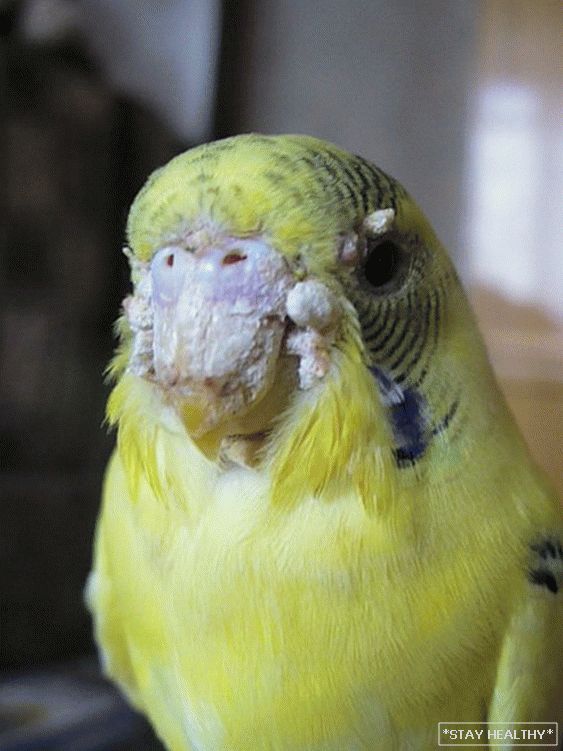 Пт, 03 июн 2016 Автор: Эльвира Корчагина
Пт, 03 июн 2016 Автор: Эльвира Корчагина
So, you decided to get a wavy parrot.
Before you go to the store or market,
determine for yourself the purpose of buying birds: you need it in
as a companion or to be used for breeding.
The further care of a wavy parrot depends on it.
Contents
Wavy parrots: the right care. How to choose a feathery
pet?
Rules for choosing a wavy parrot
It is important to take the choice of a bird seriously and to get it better from
An experienced breeder, where you can personally evaluate the conditions in which
contain birds and watch their behavior. Risk buy here
sick bird is much smaller than in the bird market.
The selected bird must be inspected. Healthy parrots are active,
their plumage fits tightly to the body and looks shiny, eyes
clean and clear without cloud. On paws should be 4 fingers
(2 are directed forward and 2 back) with claws, scales should be exactly
adjoin each other. A sick bird is immobile and indifferent to
what is happening, sits, cackling, her plumage is dim and
disheveled, and around the cloaca can be soiled with liquid
feces

The sick parrot is sitting cackling
Buy should be young parrots aged 1.5 to 3-4
months. During this period, they most quickly get used to the person and
a new place of residence, more adult birds are harder
a change of scenery is worse tamed.
How to determine the age of a parrot?
In order not to be deceived by the seller when buying a wavy
parrot and not to buy instead of a young bird the old one is worth it
learn how to determine her age by the following features:
1. On the beaks of chicks up to 2 months, there is a black “smear”, which
as they grow older, disappears;
2. Parrots younger than 3 months have a head from beak to back.
characteristic “wavy” pattern;
3. At the age of 3.5-4 months, the first “juvenile” occurs.
molt. After it ends, the parrot’s head will be yellow or
a white “cap” with remnants of barely noticeable “waves”;
4. Chicks have completely black eyes. By 5-10 months iris
eye brightens. Adult birds have a white bezel around the pupil;
5. Throat spots at a young age birds have a semicircular
shape with blurred outlines. Parrots older than 6 months have spots
clear in the form of an oval;
6. Ceres of young birds of pale lilac or pinkish
shade. After 4 months of life, the male mantra becomes
bright blue, and females beige or light blue. By 8-9 months
female celestial acquires brown color;
7. Tail feathers of young stock are shorter than that of
adults.
The above age criteria are not suitable for
variegated birds, albinos (completely white) and lutino
(completely yellow). Their beak is always bright, eyes remain
black (albino they can be dark red) for life.
Therefore, buying birds of this color is better from proven breeders,
who will not hide the true age and health
своих parrots.
How to determine the sex of a wavy parrot?
Females and males can be distinguished by the color of the waxberry (mandible,
where the nostrils are located). At a young age she has both sexes
pale lilac or mauve, only females are light
rings around the nostrils. By the 4th month of life, the mandibles in males turn blue and
getting brighter. In a female, a cerebellum acquires a pale blue or
beige shade, and after puberty (8-9 months)
turns brown.

Left – female (brown cepe), right – male
(ceres blue)
Wavy parrots: the right care. Selection and placement of cells.
How to equip the “home” wavy parrot?
Where to put the “house” for the parrot in the apartment?
The necessary criteria for the safe living of parrots in
home conditions are high-quality food, bright
cell location, cell cleanliness.
It is best to put the cage in a bright place in the room. Put on
window sill is not recommended because budgerigars are afraid
drafts. However, these birds need a long light
day – at least 12-14 hours in summer and 10-12 hours in winter. Therefore, in
The autumn / winter season requires additional lighting.
In order for a feathered pet to quickly become accustomed to the host, the cage must be
at the level of human growth.
How to choose a cell?
Cage for birds is chosen according to the following criteria:
• Shape – optimal is rectangular with a flat top. AT
it is more convenient for birds to move around. In addition to an even “ceiling”
easier to hang toys, mirror, swing;
• Size – depends on the planned location of the cell in
the apartment, the number of birds and their size. Pick up the size of the cell
so that the bird can freely spread its wings, flutter with
perches on a perch. The minimum cell parameters are 25x40x40cm;
• Location of twigs – more convenient for moving birds along
the walls of the cell are horizontal bars. Going over
him, the parrot will not slide;
• Simplicity of care for cleanliness – the simpler the cell design, the
easier to monitor its health status. AT различных украшениях
parasites, dust, down accumulate;
• Safety for birds – parrots love to walk on the bottom of the cage,
therefore, it should be solid, and not from rods. Otherwise bird
fingers or claws can get stuck between the twigs, and the bird, trying
break free, can easily break his paw;
• It is necessary to clean the cage every day, and general cleaning is carried out
monthly. For disinfection after washing the cell is wiped with a decoction
wormwood or chamomile.
Cage equipment
To make the parrots feel in their home
comfortable, the cage must be installed in different diameters
poles (at least 2 pieces), feeders, drinkers, baths, toys and
mirror.

Equipped wavy parrot cage
The perches are placed so that the bird can easily flutter with
one to another and do not pollute the feeder with their droppings and
water bottle.
Drinking bowls are better to choose glass or porcelain (water in them
longer kept fresh and clean). Daily they need to be washed hot
water and soda and wipe dry.
Porcelain or plastic feeders in a cage need at least
two: one for grain feed, the second for soft.
Bathrooms with clean warm water are placed in a cage periodically,
especially on hot summer days. After the bird took “water
procedures, the bath is cleaned.
If the parrot lives in a cage alone, then you need to hang it from the ceiling.
small mirror so that the bird is not lonely.
On a note! ATсе аксессуары и саму клетку
after purchase, you need to be sanitized, doused with boiling water, and dry
to rub.
Wavy parrots: the right care. Feeding, diet
The diet of budgies is quite diverse and includes
cereal mixtures, fruits, vegetables, herbs, mineral supplements.
Grain mixtures includes in its composition purified oats,
canary seed, flax and different degree of maturity of millet. To acquire
this food is better in a sealed package with a transparent “window”,
to visually assess the quality. AT картонных коробках зерно может
be moldy due to improper storage.
AT качестве источника витаминов, минералов и растительной
клетчатки в меню волнистых parrots должны присутствовать
vegetables, fruits, berries and seasonal greens. Birds with pleasure
gnaw juicy root vegetables such as carrots, beets, cucumbers,
zucchini, cabbage. Favorite fruits for them are apples,
peaches, pineapples, pears, citrus. Of birds, feathery pets with
enjoy the pleasure of raspberries, strawberries, strawberries.
AT весенне-летний сезон можно дать попугаям листья одуванчика,
clover, plantain, spinach, sorrel, and in the winter to grow
on greens oats, millet.
ATажно! You can not feed persimmon parrots,
mango, all kinds of nuts, celery root, dill, meat and dairy
products, potatoes, cheese, chocolate.
For the full development of the birds need and mineral fertilizer.
For example, offer sand of organic origin, chalk or
sepia (skeletal part of the cuttlefish). These substances enrich the body
parrots with calcium and other trace elements. In addition, gnawing chalk,
parrots naturally grind constantly growing
beak.
Wavy parrots: the right care. First days at home
After buying and delivering wavy parrot home, the first 2-3
weeks it should be kept separate from other birds (if they have
you).
At first, the bird will experience stress due to the change
furnishing and transportation. Therefore, you should protect your
pet from frightening factors: loud noises next to him,
obsessive attention of children and other animals (if any).
Communicate with the bird in a gentle gentle voice, do not try
forcibly take her in your hands – so you establish trust with her
relations. This process takes time, patience and endurance. After
the bird gets used to you and will fearlessly sit on
outstretched hand, you can start learning conversational
according to
Wavy parrots: the right care. Wavy disease
parrots
With improper care and non-compliance with sanitary conditions
wavy parrots are exposed to diseases such as scabies,
goiter inflammation, poisoning. ATозможны травмы лап, поражение
puhoperoedami.

Infected with knemidokoptoz (scabies) wavy
parrot
If you find the following signs, you should show
birdie the vet:
• refusal to eat;
• diarrhea;
• tarnished disheveled plumage;
• lethargy and apathy;
• nasal discharge;
• growths on the beak and legs.
The health of the feathered pet is in your hands!





